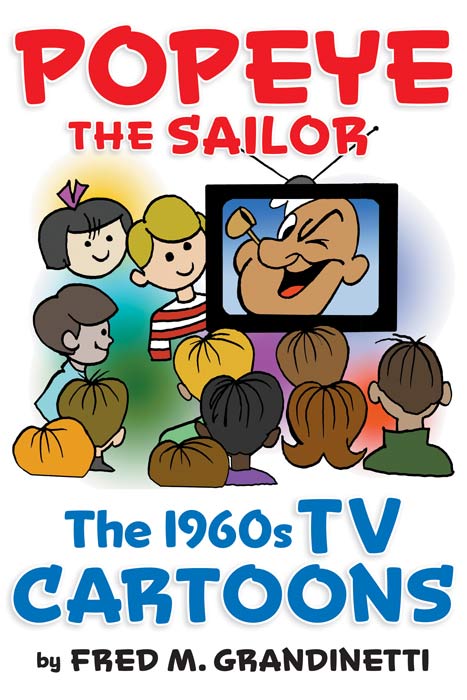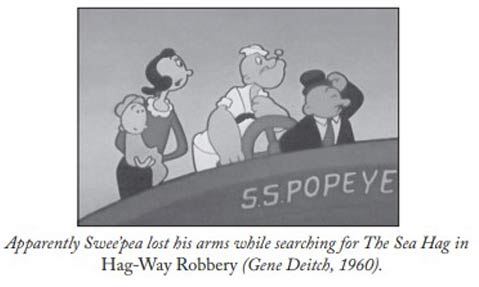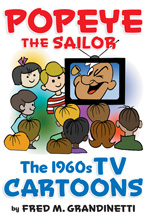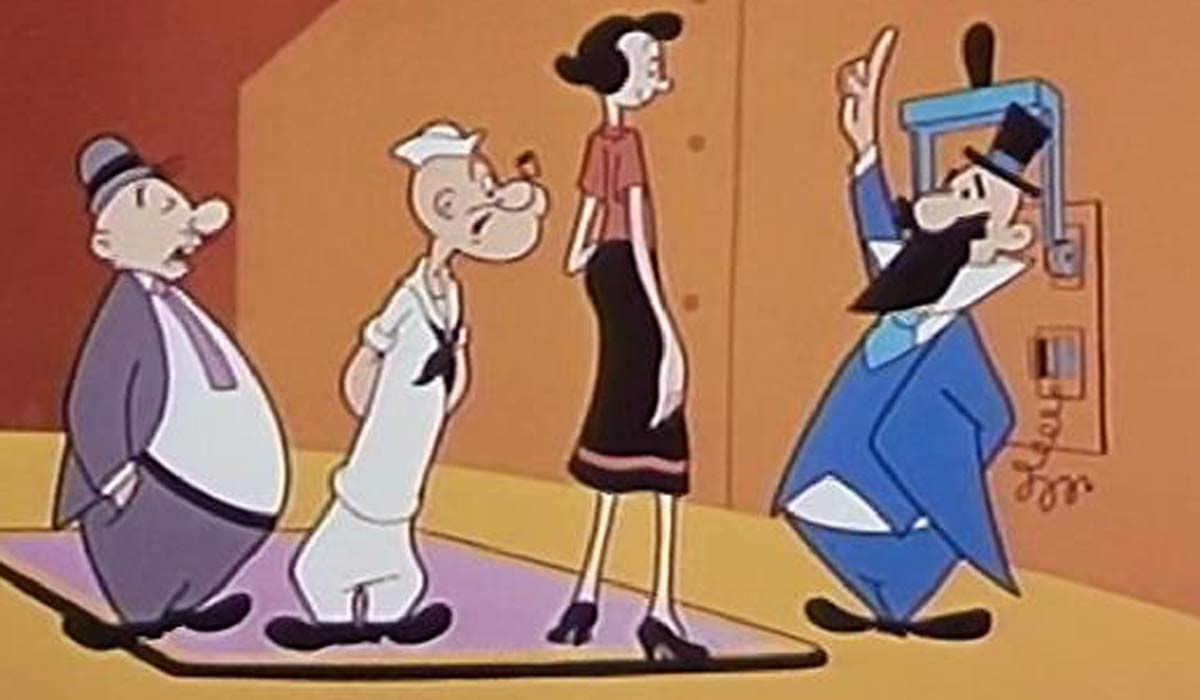 Popeye The Sailor: The 1960s TV Cartoons
Popeye The Sailor: The 1960s TV Cartoons
By Fred M. Grandinetti
BearManor Media
January 28, 2022
230 pages
Hardcover $35, Softcover $25
There are Popeye cartoons, and then there are Popeye cartoons. The good stuff, as many fans know, are the black and white Fleischer theatrical shorts of the 1930s through the early 1940s (plus their three color two-reelers), which began just a few short years after Popeye first appeared in the Thimble Theatre newspaper comic strip. The subsequent color shorts from Famous Studios (essentially what became of the Fleischer studio once Paramount took them over) in the 1940s and 1950s are still pretty good, but cannot match the amazing quality of the Fleischer ones, and over time the Famous offerings devolved into largely formulaic and bland cartoons that many fans don’t mind forgetting. And next came the television cartoons and a further, inevitable dip in quality.
Popeye animated cartoons initially entered people’s homes via television syndication of his theatrical shorts; but King Features Syndicate, the owner of the character, hoped to grab a bigger piece of the profits by producing their own series of cartoons for mainly television exhibition. The result was a package of 220 cartoons of variable quality. “Variable” might be charitable, as many fans would describe these shorts – on the whole – as cheap, poorly-animated, mistake-filled messes that offend the eyes and heart.
Ah, but Popeye superfan Fred Grandinetti would like to remind us that the KFS cartoons were not all bad, not at all. Many were decent, and a few were even pretty good; and even the bad ones are interesting in their way. He has touched on this topic previously in his book Popeye: An Illustrated Cultural History, but he has now expanded on the topic considerably in his new book, Popeye The Sailor: The 1960s TV Cartoons. Bear Manor media is offering the book in hardcover and softcover editions, for anyone for wishes to have some help in navigating through the many KFS cartoons.
 One might say, “Fred has watched them all, so that you won’t have to!” However, as you read the book, you will inevitably be curious to watch these cartoons, either to appreciate some fun Popeye action, or to pick apart the worst of the worst. Regardless, the cartoons are an important part of television history. I previously reviewed a DVD set of these cartoons, and I can confirm that the quality ranges from poor to good, and none of them can match the best of the theatrical output. The reasons for the differences is explored in Grandinetti’s book, as he describes the production history of the cartoons and the players involved. We learn of how the cartoons were farmed out to several producers, in studios across the US and Europe. It may surprise some that many of the folks involved were well-respected pros, like Jack Kinney, director of many a classic Disney short. Directorial talent, however, can only go so far, and Grandinetti details how budget, time, and the availability of animation talent adversely affected this series.
One might say, “Fred has watched them all, so that you won’t have to!” However, as you read the book, you will inevitably be curious to watch these cartoons, either to appreciate some fun Popeye action, or to pick apart the worst of the worst. Regardless, the cartoons are an important part of television history. I previously reviewed a DVD set of these cartoons, and I can confirm that the quality ranges from poor to good, and none of them can match the best of the theatrical output. The reasons for the differences is explored in Grandinetti’s book, as he describes the production history of the cartoons and the players involved. We learn of how the cartoons were farmed out to several producers, in studios across the US and Europe. It may surprise some that many of the folks involved were well-respected pros, like Jack Kinney, director of many a classic Disney short. Directorial talent, however, can only go so far, and Grandinetti details how budget, time, and the availability of animation talent adversely affected this series.
Anyone with even a passing interest in the squinty-eyed sailor should find the text interesting, as it delves into a brief history of the character in comics and animation, then proceeds to describe how the KFS cartoons came together. The main players, like Kinney, Gene Deitch, Larry Harmon and others are given concise biographies, and the various studio circumstances are described. Spin-offs of the cartoons – including merchandise and exercise campaigns – are discussed, participating television stations are identified, and there are plenty of trade ads presented. Ratings and profits are highlighted, and the success of the shorts is celebrated. This is a basically a treasure trove of TV cartoon history- and that’s all before we get to the bulk of the book, which gives a synopsis for each cartoon, consisting of a solid one or two paragraphs each, in which we learn of the story but also any trivia or animation mistakes related to the short. Most helpful in our appreciation is that the cartoons are divided by studio, and the directors are identified, with Grandinetti pointing out differences in how the series was handled depending on who worked on each cartoon. This scholarship is most welcome, as we learn to understand that this was not a uniform glob of cheap cartoons, but rather the product of many hands in several places.
This makes for a fun and informing read on a lazy Saturday afternoon, likely to be followed by seeking out the cartoons themselves either on DVD, or on YouTube, where they have all been uploaded onto the official Popeye channel. With that kind of availability, and a helpful text that contextualizes each short, it’s a great time to re-evaluate the KFS Popeye cartoons.




